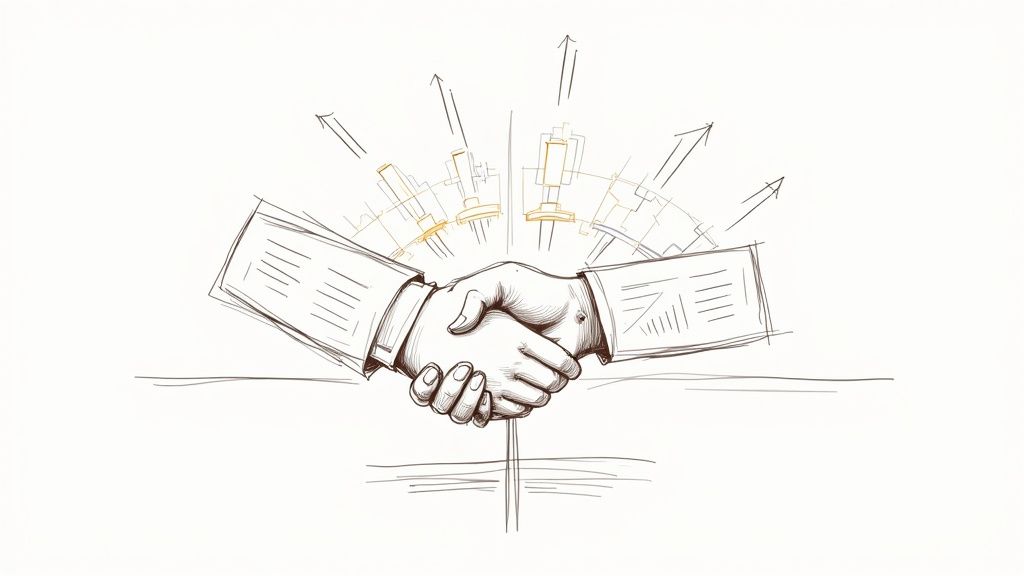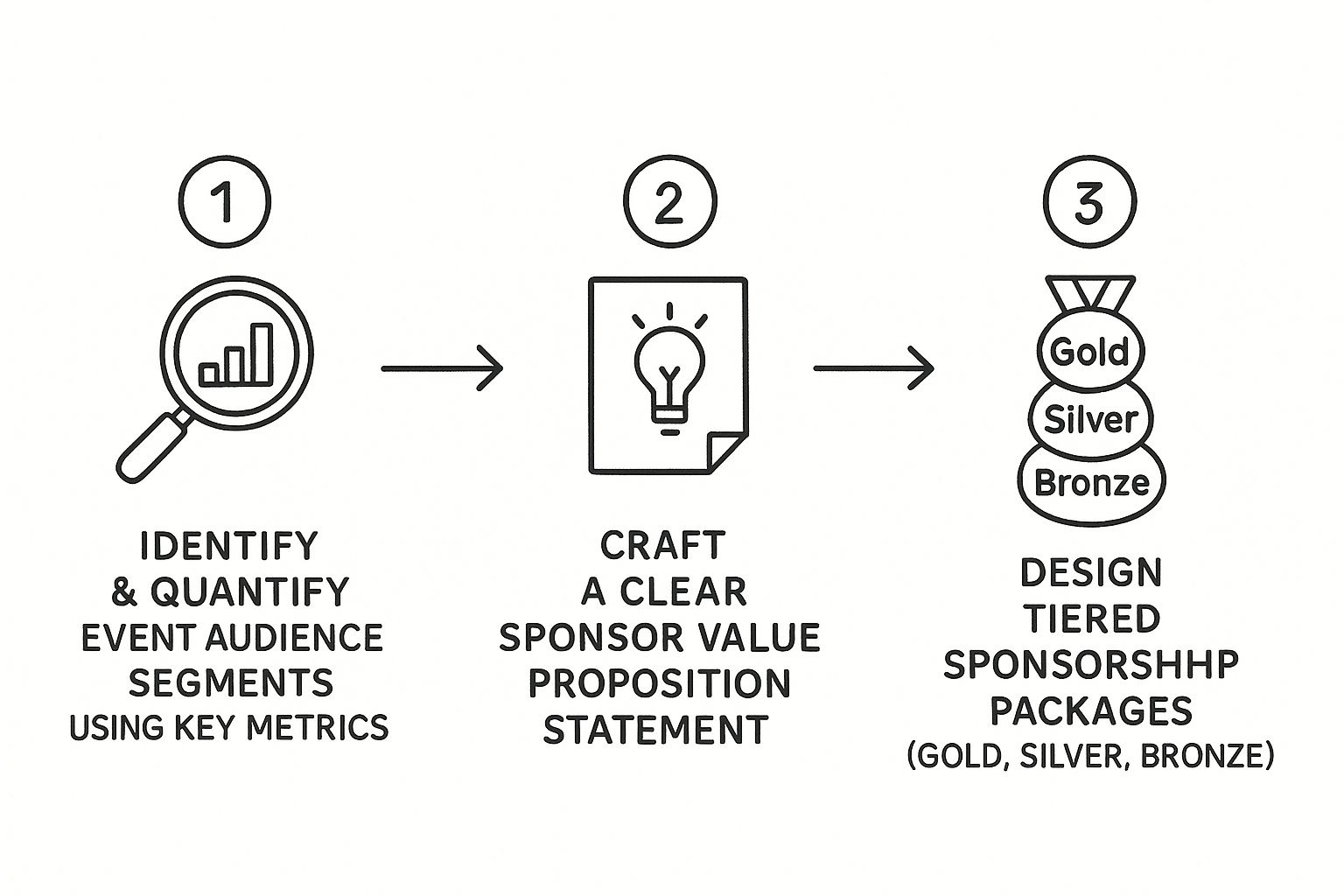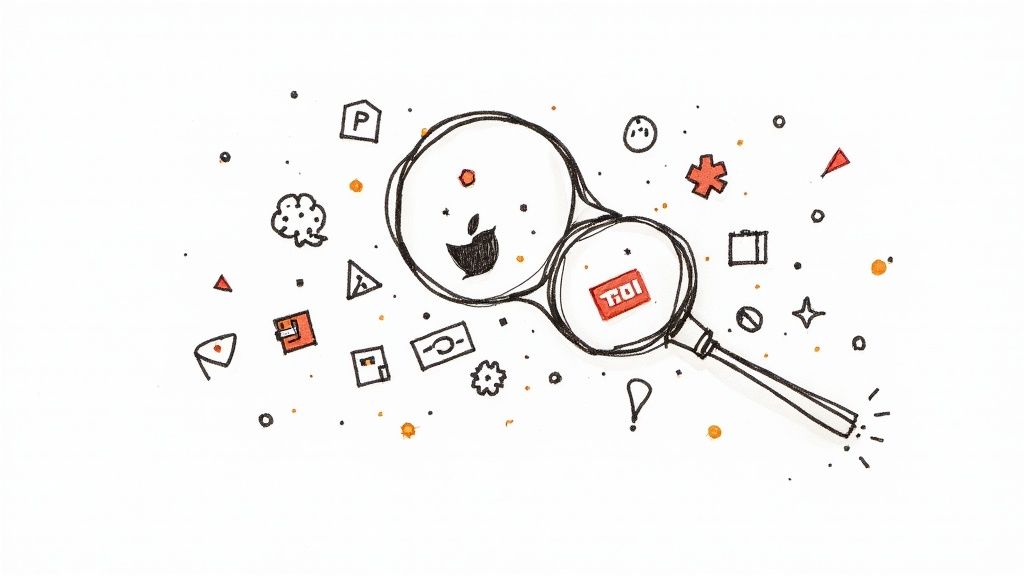October 14, 2025

Securing sponsors today is all about proving value and building strategic partnerships. It's way past just selling logo placements. The real work is in finding sponsors whose target audience is your audience, then building a case for ROI they can't ignore. You’re not just asking for money; you’re pitching them on becoming an indispensable marketing partner.
If your sponsorship strategy still revolves around a tiered "gold, silver, bronze" package, it's time for a major overhaul. The old model—slapping a logo on a banner in exchange for a check—is dead. Sponsors today are sharp investors. They want measurable returns, genuine audience engagement, and partnerships that actually align with their brand.
This shift has made sponsorship the financial backbone for most events, but it's also become the single biggest marketing headache for planners. The game has moved from passive visibility to active, data-driven participation. Sponsors aren't asking, "How many people will see my logo?" They're asking, "How will this event help us hit our Q3 sales goals?"
To win them over, you have to start thinking like a sponsor. That means digging into their marketing goals, understanding their pain points, and figuring out what they need to show their boss to justify the spend. It’s no longer about what you need from them; it’s about what your event can do for them.
Here’s how the expectations have changed:
Sponsors are no longer passive advertisers; they are active partners seeking a return on investment. Your ability to demonstrate clear, measurable value is the single most important factor in securing their budget.
Let’s be honest: the financial reality of events has made sponsorship the top priority. The data backs this up, showing that partnerships are now the number one driver of event revenue. In fact, a staggering 88.4% of event marketers see sponsorships as their most effective source of income—blowing ticket sales out of the water. For many events, survival now hinges entirely on locking in these partnerships.
This chart really puts it into perspective:

This shift is so significant that nearly a third of planners now define an event's success by the sponsorships secured, not just by how many people showed up. Things like innovative event marketing strategies, such as using event QR codes, can offer the kind of trackable engagement that sponsors are hungry for. Adopting this modern mindset is what will make your event an unmissable opportunity in a very crowded market.
Jumping into sponsorship outreach without doing your homework is a recipe for disaster. I’ve seen it happen time and time again. A successful pitch isn't about having the slickest email; it’s about having a rock-solid foundation of data, clear value, and a professional package ready to go.
Think of it this way: you wouldn't try to sell a house without taking photos or writing a description. Asking for a sponsorship without a prepared toolkit is the same thing. You might get a curious glance, but you won't get an offer. This toolkit is your blueprint for proving your event’s worth.
The single most valuable thing you're offering any sponsor is direct access to your audience. But vague descriptions like "young professionals" or "tech enthusiasts" just don't cut it anymore. Sponsors need cold, hard data to justify their investment.
This is where you need to roll up your sleeves and dig into your analytics. Who are these people, really? Go beyond the surface-level demographics and start quantifying their behaviors, interests, and professional clout.
When you have this data, your pitch completely transforms. It's no longer a hopeful ask; it becomes a compelling business case. You're offering a targeted marketing opportunity, not just a spot at an event.
Once you know exactly who your audience is, you can articulate why they matter to a potential sponsor. Your value proposition is a sharp, clear statement that immediately answers a sponsor's biggest question: "What's in it for us?"
This isn’t just a list of your event's cool features. It’s a laser-focused statement about the specific outcomes a sponsor can expect. A weak pitch says, "Sponsor our event for great brand exposure." A strong one says, "Partner with us to connect directly with 500+ FinTech decision-makers who have an average purchasing authority of $50,000." See the difference?
A powerful value proposition shifts the entire conversation. You're not asking for a donation; you're proposing a strategic partnership. You’re framing the sponsorship as a direct solution to their marketing goals, whether that’s lead generation, brand positioning, or breaking into a new market.
This whole preparatory process is really a flow of logic, where one step builds directly on the next.

As you can see, understanding your audience is the crucial first move. It informs your value proposition and helps you build sponsorship packages that actually make sense.
Let's be honest: the generic "Gold, Silver, Bronze" tiers are tired. They often fail to offer distinct, compelling value. It’s time to design packages that solve different business problems for different types of sponsors. Each level needs to offer a clear, logical step up in benefits and impact.
Instead of generic labels, think in terms of sponsor goals:
For a much deeper look at this, check out our guide on creating irresistible event sponsorship packages that deliver real, tangible benefits. The goal is to move beyond simple logo placements and offer activations that create meaningful interactions.
A well-structured table can make it incredibly easy for potential sponsors to see the escalating value.
Here’s a sample breakdown of how benefits can be structured across different tiers to show clear, escalating value.
This side-by-side view helps sponsors instantly grasp what they get for their investment, making their decision process much simpler.
Your sponsorship deck is your #1 sales tool. It’s the document that brings everything together into one professional, data-rich presentation. It needs to tell a compelling story about your event and why sponsoring it is a can't-miss opportunity.
A winning deck has to be visually appealing and easy to scan. Busy marketing execs don't have time to read a novel. Make sure it includes:
With this complete toolkit in hand, you're no longer just another planner asking for money. You're a strategic partner approaching businesses with a valuable marketing opportunity that is backed by data and designed for their success.

If you’re just blasting out generic sponsorship proposals, you’re setting yourself up for a full inbox of rejections—or worse, total silence. Securing real event funding isn’t a numbers game. It’s a strategic mission to find brands that genuinely connect with your audience and your event’s core purpose.
Shifting your mindset from volume to value is what separates the planners who constantly struggle for budget from those who build incredible, high-value partnerships. It’s all about pouring your energy into prospects with real potential. This approach doesn't just boost your response rate; it builds a foundation for relationships that can last for years.
Forget starting with a blank Google search. Your hunt for the perfect sponsor should begin right in your own backyard—within the communities and industries that already align with your event. The best partners are often hiding in plain sight.
Here are a few research tactics that actually work:
This initial legwork helps you build a "dream list" of potential sponsors, but more importantly, it gives you a peek into their marketing playbook before you ever reach out.
Finding the right company is only half the battle. You have to find the right person. Firing off a proposal to a generic info@company.com email address is like throwing it into a black hole.
This is where LinkedIn becomes your best friend. Start searching for people with titles like:
Once you've found a few promising contacts, do a little digging. Check out their recent activity. Did they just post about a new company initiative or a campaign they’re proud of? This information is pure gold. When you can tie your event directly to a goal they've already shared publicly, your pitch becomes incredibly relevant and hard to ignore. For more on this, check out our deep dive on how to obtain sponsorships from corporations.
A truly great partnership is about more than just a shared customer base. Today, brands are laser-focused on values-based marketing, which creates a massive opportunity for event planners who can show a deeper connection.
A huge trend we’re seeing is the focus on social impact, sustainability, and DEIB (diversity, equity, and inclusion). Brands aren't just looking for eyeballs anymore; they want their sponsorships to reflect their real-world commitments to environmental, social, and governance (ESG) goals. The Global Sponsorship Trends Report highlights just how important this has become.
Does your event support a local charity? Do you champion underrepresented voices in your industry? Are you committed to sustainable practices? Make sure to highlight these things. Showing a sponsor that a partnership with you won't just hit their marketing KPIs but will also boost their corporate social responsibility cred can be the thing that seals the deal.
Before you sink hours into crafting the perfect, customized proposal, you need to qualify your prospects. A quick check can save you from chasing dead ends and lets you focus your energy where it truly counts.
Run each potential sponsor through this quick checklist:
By being meticulous about finding and qualifying sponsors, you completely change the conversation. You’re no longer just asking for a check; you're strategically presenting an unmissable opportunity to the right partner at exactly the right time.
Your first email is everything. It's your only shot to cut through the noise and show a potential sponsor that your event is a genuine opportunity, not just another marketing expense. A generic, copy-pasted email is a fast track to the trash folder. Real success comes from doing your homework, telling a good story, and putting their needs first.
The whole point of your initial email and proposal is to make saying "yes" easy for them. You aren't just asking for money; you're offering a solution to a problem they have. This is where all that research you did on your audience and their potential marketing goals pays off, coming together to create a pitch they can't ignore.

This is where having solid data becomes your superpower. Using a platform like GroupOS, you can pull together the kind of rich audience insights that make a pitch truly compelling. That detailed understanding of your community is what turns a good proposal into a great one.
Let's be honest: the cold email is an art. Its only job is to get a reply. That’s it. You just need to earn the right to send them your full proposal. So, forget the long-winded story about your event's history. Your email needs to be short, sharp, and all about them from the very first line.
Your subject line is the first test. It has to be intriguing without sounding like spam. Something like "Partnership idea for [Sponsor's Company] x [Your Event Name]" feels collaborative and personal. Vague lines like "Sponsorship Opportunity" are dead on arrival—I’ve seen it happen a thousand times.
In the email itself, that first sentence must prove you've done your homework. Mention a recent campaign they launched, a new product, or a company value you admire. It's an instant signal that you're not just blasting a list. Aim for three short paragraphs, max.
This approach respects their time and gets them curious, which makes them far more likely to agree to see what you have to offer. For more great examples, our deep-dive article on how to ask for a sponsorship has templates you can run with.
Once they give you the green light, your sponsorship deck has to seal the deal. This isn't just a brochure listing prices; it's a visual story that helps the sponsor imagine a successful partnership with you. It needs to be clean, packed with data, and easy to skim.
A great deck tells a story. It starts by identifying a challenge they face (like reaching a very specific, high-value audience) and presents your event as the perfect solution. The flow should be logical, guiding them straight to a confident "yes."
Think of your proposal less like a menu and more like a business case. Every slide should build on the last, proving that sponsoring your event is a smart investment that will deliver real, measurable results.
As you put your pitch together, remember they're looking at other options. You need to clearly show how your event provides effective event marketing strategies for sponsors that will actually improve their ROI. When you show you understand their world, you build instant credibility.
To make your proposal truly shine, make sure it covers these essential bases. Each section should be easy to digest and answer their questions before they even think to ask them.
Getting an enthusiastic response to your proposal is an incredible feeling, but it’s not the finish line. This is where you shift gears from pitching to partnering, and it takes a careful blend of confidence, timely follow-up, and solid paperwork to get the deal signed.
The goal here is to keep the momentum going without coming across as desperate or pushy. I’ve found that a simple follow-up about a week after sending the proposal works wonders. Don't ask for a decision. Instead, frame it as a helpful check-in. Something as simple as, "Just wanted to see if you had any questions about the proposal I sent over last week," keeps the conversation open and collaborative.
It’s almost unheard of for a sponsor to accept a proposal as-is. You should expect some pushback on things like price, the specifics of the benefits, or exclusivity. When this happens, don’t get defensive. See it for what it is: an invitation to start a real conversation.
The most common objection, without a doubt, is the budget. When you hear, "This is a bit more than we were expecting to spend," your first instinct might be to slash the price. Resist that urge. Instead, bring the conversation back to the value you’re offering. Ask them questions to dig into what they really want to achieve.
Great negotiation isn’t about one person winning. It's about getting creative to find a solution where you both walk away feeling like you got a fantastic deal. Be ready to adjust the benefits, but hold firm on the price point that reflects your event's true worth.
This approach instantly positions you as a strategic partner who is invested in their success, not just a salesperson. It builds the trust needed for a strong, long-term relationship. Knowing when to be flexible and when to stand your ground is a core skill for anyone learning how to gain sponsorship for an event.
Once you've shaken hands on the terms, it's time to make it official. A verbal "yes" is a great start, but the signed contract is what seals the deal. This document doesn't need to be 50 pages of dense legalese, but it absolutely must be clear and protect both you and your sponsor.
At a minimum, your agreement should clearly spell out:
With the contract signed, the last hurdle is getting paid. You’ve come this far, so make this part as easy as possible for them. Offer multiple ways to pay, like a credit card portal, bank transfer, or even a check. A smooth payment experience leaves a great final impression and means the funds are in your account, officially closing the deal.
Diving into the world of event sponsorship can feel overwhelming. There are so many moving parts, and it’s tough to know where to start. To help you out, I’ve pulled together the most common questions I hear from event planners and provided some straight-up, practical answers to get you on the right track.
The honest answer? Probably earlier than you think. You really want to start your outreach a good 6-12 months before your event.
I know, that sounds like a ton of time. But big companies, especially the ones with deeper pockets, have rigid budget cycles. You need to get your proposal in front of them while they're still deciding where next year's money is going. Starting early gives you breathing room for all the back-and-forth—the initial research, crafting a pitch that actually lands, follow-ups, negotiations, and getting the contract signed without a last-minute panic. It shows you're a pro who has their act together.
Easy. Sending a generic, one-size-fits-all proposal. It's the fastest way to get your email deleted. Nothing screams "I don't care about your company" more than a pitch that could have been sent to anyone. You have to show you've done your homework.
Before you even dream of hitting "send," you should know:
A pitch that connects your event directly to their goals will always win over a generic email blast. It’s about respecting their time and proving you’re a serious potential partner, not just another person with their hand out.
Yes, you should. It’s best to include starting prices for your sponsorship tiers. Transparency builds trust right off the bat and helps you filter out companies that just don't have the budget. It saves everyone a lot of time.
The trick is in the phrasing. Always frame your tiers as "starting at" a certain price. This signals that you're flexible and open to discussion. It sets a clear expectation of value but leaves the door wide open for creating a custom package that works for them.
By listing prices, you immediately anchor the conversation around value. It also empowers the sponsor, letting them quickly see where they might fit in and making the whole process feel much smoother.
Your goal is to show you have thought-out packages but are ultimately focused on building a true partnership.
A "no" isn't a dead end. Think of it as a chance to learn something. Instead of just shrugging and moving on, always respond politely and ask if they'd be open to sharing any feedback. Finding out why it wasn’t a fit is gold for your future pitches.
Was it the budget? The timing? Or did their marketing goals just not line up? This kind of insight helps you sharpen your pitch and target smarter next time. Plus, it keeps the door open. End the conversation by asking if you can keep them in mind for future events. Their priorities (and budgets) might look very different a year from now.
The sponsorship game is always changing. Brands dropped a whopping $97.4 billion on sponsorships in 2022, and that number is expected to hit $189.5 billion by 2030. A huge driver of this growth is the shift to digital and hybrid events, which now account for a combined 74.5% of all events. Sponsors are actively looking for digital opportunities with better analytics, a trend that could easily influence their decision next year. You can learn more about these sponsorship statistics and trends to see just how quickly the market is moving.
Ready to stop juggling spreadsheets and bring your entire sponsorship process under one roof? GroupOS is an all-in-one platform built to manage memberships, ticketing, and sponsor engagement, complete with the analytics you need to prove your value. See how you can build better partnerships and make your next event a massive success.


